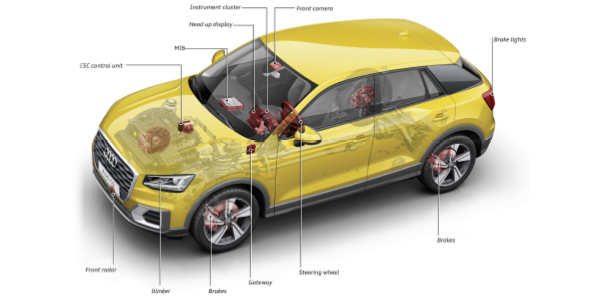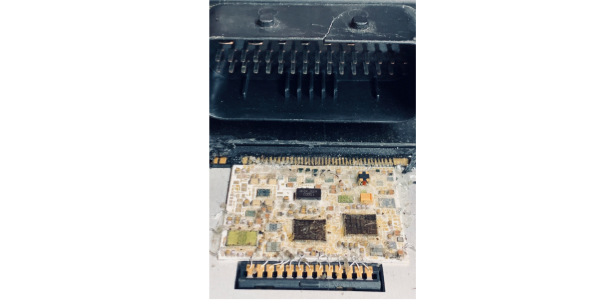
At last count, more than 800 TSBs have been issued concerning reflashing or reprogramming over the past five years. These numbers do not include the random updates that seem to appear out of thin air on the OE service information websites. Also, OEMs are using more modules that communicate on network.
Basic cars will have at least 10 modules, while luxury vehicles may have more than 25. Some may see this as a problem – but forward-thinking shops should see this as an opportunity.
If you think reflashing and reprogramming is just an underhood or emissions exercise, you are wrong. Many of these updates concern the ABS and Stability Control associated systems that do not involve engine operation, but need information from other modules to function.
Over the past five years, the language of reprogramming, reflashing and system updates has become confusing for both technicians and consumers. The key is to understand WHY you have to reflash and WHAT doing so means.
WHY

Reflashing updates aren’t just for cars that are still under warranty. A lot of the updates are for vehicles that are past warranty to resolve problems occurring as they have accumulated miles and wear and have seen conditions not anticipated by the automaker.
Reprogramming and recalibrating is a process in which modules are programmed with the information needed to operate and communicate with other modules on the vehicle. This is why most modules need to be serviced on the vehicle.
Most vehicles built after the model year 2000 have a network of modules that talk to each other. On some of those first vehicles, it was the ABS, transmission and engine control modules that were networked together on a Controller Area Network (CAN) bus. As vehicle complexity has increased over the past 20 years, modules like the instrument cluster, body control and steering are now talking on the same CAN bus. In addition, some of the modules on the CAN bus act as gateway and translation modules for other networks in the vehicle.
The modules use a language that has grammar and protocols for communication, so the messages do not collide with each other. A module on an electric steering rack could tell the engine control module to increase the throttle angle because the driver is turning. Or it could be as complex as a door module with an antenna for the keyless entry module talking to a body control module on one network that confirms the security signal to allow the driver to enter the vehicle and then communicates over the CAN bus to allow the engine to start.
When a module is talking or receiving signals from a bus, the messages typically contain an identifier of which module is communicating. When a module is programmed on a vehicle, it begins teaching the module the configuration of modules and protocols.
Information like key transponder codes and even TPMS sensor IDs might be part of the reprogramming configuration. This is why just swapping some modules does not work. It is also why after replacing a component connected to a network, additional procedures like reprogramming are required.

WHAT
To perform reflashing and reprogramming tasks, you need a way to communicate with not only the engine control module, but other modules on the vehicle. A J2534 pass-thru programmer is an interface that acts as a gateway that translates the messages back and forth between the PC and controller into a protocol that is understood by the vehicle. It’s a box and/or cable able to connect the PC to the vehicle and communicate with the correct pins on the OBD II connection. Most reflashing methods require the use of the four pins in the DLC that are open to the manufacturer.
Some dedicated scan tools can perform some reprogramming procedures using a J2534 pass-thru box, but for a lot of jobs, you are going to need a Windows-based PC. Purchasing and setting up a PC can be the most challenging part of reflashing. Most OEMs require a Windows-based PC with specific hardware, operating system requirements and user settings. Most OEMs specify Vista and Windows 7 and some systems specify that the system be 32- or 64-bit versions of Windows. Make sure to read all of the OEMs’ recommendations for the largest volume of vehicles you plan to reflash.
You will need to subscribe to the OEM’s service information website. Subscription fees vary by OEM and have several payment options. Make sure you write down the logins and passwords. Before you start reflashing, take time to register and navigate the OEMs’ websites.
You will not be able to perform flash reprogramming straight out of the box. It takes time to set up the computer and register at the OEM websites so, on a slow day, take some time to experiment on shop vehicles. See what’s involved. Nothing is worse than having to wait for a verification email from an OEM to start up a subscription. Learn before you burn.
Reflashing and reprogramming is a necessary service for repairing your customers’ vehicles, and its importance is only going to increase. OEMs are issuing more TSBs that require reflashing every day. Turning away a job or not telling the customer about an updated reflash program because you can’t reflash yourself is going to hurt your business in both the short and long term.
Article courtesy Brake & Front End.













